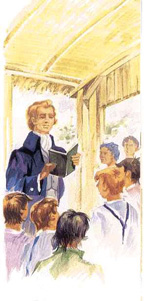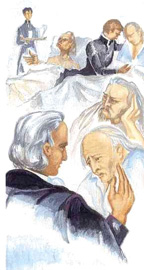- Details
-
Hits: 24761
An Italian artist, Norberto Pasqualini, looks at the life of Edmund Rice
Beginnings
| Edmund grew up on a prosperous farm in Callan, in Co Kilkenny, Ireland.. He knew horses and cows and pigs and was familiar with all the sights and sounds and smells that are part of a farmyard. Working on a farm helps a person to keep his feet on the ground. Edmund learnt this lesson early in his life and was later known for his balanced personality. |
 |
 |
Edmund's future lay in commerce. His uncle invited him to join his business in Waterford. Edmund is shown as a young, energetic young man walking along the quay on the Suir River at Waterford. He eventually took over the business, which involved provisioning ships and exporting cattle. The future looked rosy for this young man who was fast becoming very successful. |
| In his mid twenties and at the top of his profession, Edmund married his wife, Mary. The artist depicts them on their wedding day as they face life together. Their cup was brimming over with happiness. |
 |
 |
| Tragedy struck when Edmund’s wife died giving birth to their first child after little more than a year of marriage. Edmund’s whole world collapsed. Grief-stricken, he hardly knew where to turn. This loss burnt deeply into his being, profoundly affecting his outlook. |
|
| Edmund’s newly-born daughter, named Mary after her mother, was a sickly child. Edmund devoted himself to caring for her, aided by his step-sister, Joan, who became his housekeeper |
 |
Searching
| After the death of his wife, Edmund turned increasingly to God. He read the bible frequently, seeking insights about the direction his life would now take. As a businessman, he was particularly attentive to what the bible said about money. He began to think of ways in which he could use his wealth for the good of others, especially the poor. |
 |
 |
A second source of strength for Edmund was frequent attendance at Mass and the reception of the sacraments. Jesus became a reality in his life |
| Edmund began to give generously to the poor of Waterford, supporting mant needy families |
 |
 |
A significant moment in Edmund’s life was a comment made to him by a lady friend. She knew that he was thinking of becoming a monk in a monastery in Europe, but she said to him as they watched the poor, ignorant children playing in the street below the room where they were talking that it could be God’s will that he devote himself to the lifting up of the poor boys, so much in need of a Christian education |
| Edmund began to think of founding a religious congregation for the education of poor boys. He sought advice from friends he trusted. |
 |
Giving
| In 1802 Edmund took the plunge and began teaching the poor boys of Waterford, first in a stable and then in the school rooms he built at Mt Sion. Many considered his scheme could not succeed but, trusting in Providence, he began his work. At first he had some paid helpers but when these gave up because of the difficulty of the work, he continued alone. Then some generous young men joined him, becoming the nucleus of his congregation of religious educators |
 |
 |
The boys, unused to discipline, took a while to settle but eventually their good conduct and studious habits won the admiration of all in Waterford. Edmund counselled his brothers: “Have confidence. The good seed will grow up in the children’s hearts later on.” |
| Edmund built a bakery and tailor shop to meet the needs of the poor students who came to his school. He employed bakers to make bread each day for those who needed food and tailors to provide the poor with respectable clothes. Edmund’s bakery and tailor shop still stand in the grounds of Mt Sion. |
  |
 |
| Gradually the number of brothers grew so that Edmund was able to open schools in other parts of Ireland. The brothers absorbed his spirit during their training at Mt Sion, Edmund inspiring them and forming them in their vocation. |
|
| Edmund and the brothers were always aware of the need the poor had for the simple but essential things of life. He provided food for them in the towns where the brothers worked. One who knew him well said, "he was father and mother to the poor". |
 |
 |
Alert to the needs of others, Edmund turned some of his schools into hospitals when the plague broke out in some parts of Ireland. The brothers served the sick, Edmund being sure that God would safeguard his brothers from the dangers they were facing in the work they were doing. |
| Edmund was a regular visitor to the gaols, comforting those who were imprisoned. Men about to be hanged would ask that Edmund stand beside them as they faced death, such was their trust in him. |
 |
 |
Edmund opened his whole heart to Christ present and appealing to him in the poor. His trust in God was absolute. “Providence is our inheritance” was one of his mottos. Through his personal efforts and the work of his brothers, he reached out to the poor in Ireland, England and Gibraltar. Today Edmund’s brothers carry on his vision in 27 countries throughout the world, attempting to be true to the words of Jesus in the gospels: “I have come that they may have life.”
Edmund died in 1844. He was beatified by Pope John Paul II in 1996. His feast day is 5 May, the anniversary of the day when the foundation stone of his first school, Mt Sion, was laid. |


























